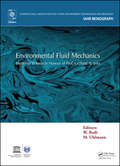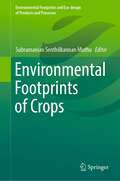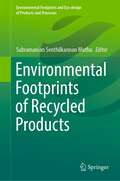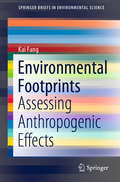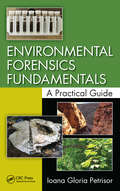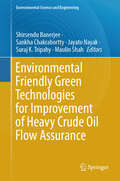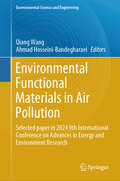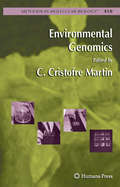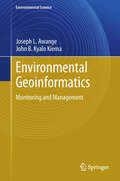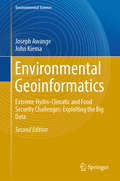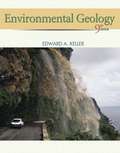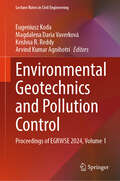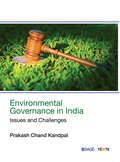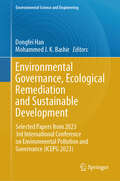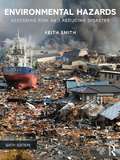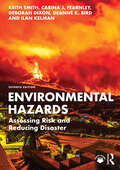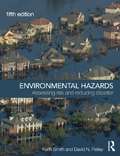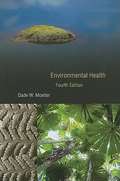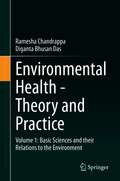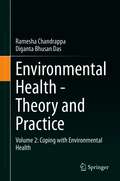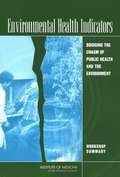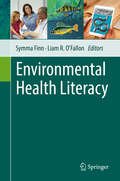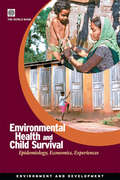- Table View
- List View
Environmental Flotation Engineering: Volume 12 (Handbook of Environmental Engineering #21)
by Lawrence K. Wang Nazih K. Shammas Donald B. Aulenbach Mu-Hao Sung WangThis volume covers topics on humanitarian engineering education of the Lenox Institute of Water Technology and recent advances in potable water and wastewater flotation processes. The specific advancements covered include: chemical coagulation and precipitation enhancements, first wave of flotation advancement for potable water treatment, second wave of flotation technology advancement for wastewater treatment, innovative circular gravity flotation, fiber detection, fiber separation, independent physicochemical wastewater treatment systems, primary flotation clarification, secondary flotation clarification, tertiary treatment, activated sludge and flotation wastewater treatment, cold weather wastewater conditions, operation and performance of the AquaDAF process system, operation and performance of the Clari-DAF process system, water purification, spectrophotometric determination of dissolved proteins, biological and physicochemical sequencing batch reactors, and sedimentation and flotation comparisons. The book will be of value to advanced undergraduate and graduate students, to designers of flotation systems, and to scientists and researchers.
Environmental Fluid Mechanics: Memorial Volume in honour of Prof. Gerhard H. Jirka (IAHR Monographs)
by Wolfgang Rodi Markus UhlmannThis book contains the written versions of invited lectures presented at the Gerhard H. Jirka Memorial Colloquium on Environmental Fluid Mechanics, held June 3-4, 2011, in Karlsruhe, Germany. Professor Jirka was widely known for his outstanding work in Environmental Fluid Mechanics, and 23 eminent world-leading experts in this field contributed to
Environmental Footprints of Crops (Environmental Footprints and Eco-design of Products and Processes)
by Subramanian Senthilkannan MuthuThere are multiple variants of environmental footprints such as carbon footprint, ecological footprint, water footprint, nitrogen footprint and so on. There are numerous developments in terms of measuring the environmental footprints of various products. Many new indicators are being developed in terms of footprints to measure the environmental performance of various products. The need to measure various environmental footprints of agricultural crops is obvious and does not need any explanation these days when the importance of sustainability is felt so much and being practiced in all industrial sectors, including agriculture. This book presents five interesting chapters pertaining to environmental footprints of crops.
Environmental Footprints of Recycled Products (Environmental Footprints and Eco-design of Products and Processes)
by Subramanian Senthilkannan MuthuRecycling is the need of the hour and it is an inevitable destination at the end of the life of any product. Today, recycling can happen at postindustrial and post-consumer states and the importance of recycled products in the market has gained significant importance. Recycled products dominate the array of sustainable products in today’s context. Even though there are commercial implications for recycling, one of the very important and obvious reasons to go for recycling and to have recycled products is to have the benefits on environmental sustainability. It is highly important to assess the environmental footprints of recycled products and further improve the environmental benefits of such recycled products. This book presents five interesting chapters pertaining to the environmental footprints of various recycled products.
Environmental Footprints: Assessing Anthropogenic Effects (SpringerBriefs in Environmental Science)
by Kai FangThis book focuses on environmental footprints that have attracted considerable interest and discussion within academia, policy makers and the public as a tool to assess anthropogenic effects on the environment. It begins with an overview which provides a starting point for understanding the concept of environmental footprints. On the basis of a thorough investigation into the theoretical and methodological aspects of selected environmental footprints that have been widely adopted, a unified framework for structuring, categorizing and integrating various footprint indicators is established. Furthermore, the book brings clarity to the relationship between footprint analysis and life cycle assessment, and challenges the isolation of environmental footprints and planetary boundaries. The findings provide novel insights into the development of environmental footprints for environmental impact assessment and environmental sustainability assessment.
Environmental Forensics Fundamentals: A Practical Guide
by Ioana Gloria PetrisorA Practical Guide to Environmental Crime Scene InvestigationsReleasing contaminants into the environment-whether deliberate or unintentional-can be thought of as a crime against the environment. The role of environmental forensics is to identify and prevent environmental pollution, or crimes. Environmental Forensics Fundamentals: A Practical Guide
Environmental Friendly Green Technologies for Improvement of Heavy Crude Oil Flow Assurance (Environmental Science and Engineering)
by Maulin Shah Sankha Chakrabortty Jayato Nayak Shirsendu Banerjee Suraj K. TripahyThis book focuses on microbial prevention, the employment of specific segregated microorganisms which can be environmental-friendly and efficient technique for both prevention and degradation of wax in pipelines and during enhanced oil recovery (EOR). The demand for oil and gas as a primary source of energy is expected to reach to about 110 million barrels per day by 2040. Discovery of new conventional oil fields has declined, while its demand has risen rapidly in the last decade as crude oil still remains the primary source of energy. Hence, oil industries face a challenge of increasing production and transportation of crude oil from reservoirs which are unconventional. Reservoir to refinery transportation of heavy and waxy crude oils requires more technical expertise due its high viscosity, high asphaltene, and paraffin content along with wax deposition and agglomeration of wax on the inner walls of the pipelines and equipments. This book also boosts the knowledge of students, researchers, scientists, professors, engineers, and professionals who aspire to work in the field of petroleum engineering and related fields of oil production and transportation, environmental science, environmental biotechnology, environmental microbiology, civil/environmental engineering, eco-toxicology, and other relevant areas of sustainable technologies by helping them understand all the necessary technicalities of organic deposition phenomenon, i.e., cause, process, problems arising due to deposition, detection of the parameters responsible for the deposition, mitigation and most importantly, and its eradication.
Environmental Functional Materials in Air Pollution: Selected paper in 2024 9th International Conference on Advances in Energy and Environment Research (Environmental Science and Engineering)
by Qiang Wang Ahmad Hosseini-BandegharaeiThis book offers readers with analysis of the main causes of air pollution and related functional materials application and research.Air, as the primary element on which human life depends, directly impacts human living and health. However, a 2022 report from the World Health Organization indicated that "the air nearly the entire global population (99%) breathes exceeds WHO air quality limits, threatening their health". Currently, the main approaches to air pollution involve source control and the treatment of air pollutants, with significant emphasis on the research and application of functional materials.With the development of material science, an increasing number of high-performance materials have been introduced into the field of air pollution control and have achieved good results. For instance, nanocomposite materials and bio-based materials. In addition, novel sensing materials have also enabled us to monitor air pollution more stably and accurately, especially for specific pollutants. Moreover, they play a crucial role in understanding the distribution, sources, and trends of pollution.It provides engineers and researchers in the field of air pollution control with research findings related to this area and the corresponding functional materials. It aims to share specific and valuable knowledge and content to improve air pollution control efforts.
Environmental Genomics
by C. Cristofre MartinHere is a manual for an environmental scientist who wishes to embrace genomics to answer environmental questions. The volume covers: gene expression profiling, whole genome and chromosome mutation detection, and methods to assay genome diversity and polymorphisms within a particular environment. This book provides a systematic framework for determining environmental impact and ensuring human health and the sustainability of natural populations.
Environmental Geoinformatics
by Joseph L. Awange John B. Kyalo KiemaThere is no doubt that today, perhaps more than ever before, humanity faces a myriad of complex and demanding challenges. These include natural resource depletion and environmental degradation, food and water insecurity, energy shortages, diminishing biodiversity, increasing losses from natural disasters, and climate change with its associated potentially devastating consequences, such as rising sea levels. These human-induced and natural impacts on the environment need to be well understood in order to develop informed policies, decisions, and remedial measures to mitigate current and future negative impacts. To achieve this, continuous monitoring and management of the environment to acquire data that can be soundly and rigorously analyzed to provide information about its current state and changing patterns, and thereby allow predictions of possible future impacts, are essential. Developing pragmatic and sustainable solutions to address these and many other similar challenges requires the use of geodata and the application of geoinformatics. This book presents the concepts and applications of geoinformatics, a multidisciplinary field that has at its core different technologies that support the acquisition, analysis and visualization of geodata for environmental monitoring and management. We depart from the 4D to the 5D data paradigm, which defines geodata accurately, consistently, rapidly and completely, in order to be useful without any restrictions in space, time or scale to represent a truly global dimension of the digital Earth. The book also features the state-of-the-art discussion of Web-GIS. The concepts and applications of geoinformatics presented in this book will be of benefit to decision-makers across a wide range of fields, including those at environmental agencies, in the emergency services, public health and epidemiology, crime mapping, environmental management agencies, tourist industry, market analysis and e-commerce, or mineral exploration, among many others. The title and subtitle of this textbook convey a distinct message. Monitoring -the passive part in the subtitle - refers to observation and data acquisition, whereas management - the active component - stands for operation and performance. The topic is our environment, which is intimately related to geoinformatics. The overall message is: all the mentioned elements do interact and must not be separated. Hans-Peter B ahr, Prof. Dr.-Ing. Dr.h.c., Karlsruhe Institute of Technology (KIT), Germany.
Environmental Geoinformatics: Monitoring And Management (Environmental Science And Engineering / Environmental Science Ser.)
by Joseph Awange John KiemaThis second edition includes updated chapters from the first edition as well as five additional new chapters (Light detection and ranging (LiDAR), CORONA historical de-classified products, Unmanned Aircraft Vehicles (UAVs), GNSS-reflectometry and GNSS applications to climate variability), shifting the main focus from monitoring and management to extreme hydro-climatic and food security challenges and exploiting big data. Since the publication of first edition, much has changed in terms of technology, and the demand for geospatial data has increased with the advent of the big data era. For instance, the use of laser scanning has advanced so much that it is unavoidable in most environmental monitoring tasks, whereas unmanned aircraft vehicles (UAVs)/drones are emerging as efficient tools that address food security issues as well as many other contemporary challenges. Furthermore, global navigation satellite systems (GNSS) are now responding to challenges posed by climate change by unravelling the impacts of teleconnection (e.g., ENSO) as well as advancing the use of reflected signals (GNSS-reflectometry) to monitor, e.g., soil moisture variations. Indeed all these rely on the explosive use of “big data” in many fields of human endeavour.Moreover, with the ever-increasing global population, intense pressure is being exerted on the Earth’s resources, leading to significant changes in its land cover (e.g., deforestation), diminishing biodiversity and natural habitats, dwindling fresh water supplies, and changing weather and climatic patterns (e.g., global warming, changing sea level). Environmental monitoring techniques that provide information on these are under scrutiny from an increasingly environmentally conscious society that demands the efficient delivery of such information at a minimal cost. Environmental changes vary both spatially and temporally, thereby putting pressure on traditional methods of data acquisition, some of which are highly labour intensive, such as animal tracking for conservation purposes. With these challenges, conventional monitoring techniques, particularly those that record spatial changes call for more sophisticated approaches that deliver the necessary information at an affordable cost. One direction being pursued in the development of such techniques involves environmental geoinformatics, which can act as a stand-alone method or complement traditional methods.
Environmental Geology 9th Edition
by Edward A. KellerHaving originally defined the Environmental Geology course, this is considered the most comprehensive yet readable book for your course level. Keller continues to offer the most detailed, current research available. He covers a wide range of topics, discussing everything from fundamental geologic principles to the specifics of environmental law and geologic hazards, from a truly environmental perspective. The Ninth Edition emphasizes the engineering geology approach, especially in the discussion of soil and rock mechanics and landslides.
Environmental Geotechnics and Pollution Control: Proceedings of EGRWSE 2024, Volume 1 (Lecture Notes in Civil Engineering #580)
by Krishna R. Reddy Arvind Kumar Agnihotri Eugeniusz Koda Magdalena Daria VaverkováThis volume contains peer-reviewed and selected papers presented during the International Conference on Environmental Geotechnology, Recycled Waste Materials, and Sustainable Engineering 2024, held in Warsaw, Poland. It covers the recent innovations, trends, concerns, practical challenges encountered, and the solutions adopted in waste management and engineering, geotechnical and geoenvironmental engineering, infrastructure engineering, and sustainable engineering. This book will be useful for academics, educators, policymakers, and professionals working in the field of civil engineering, chemical engineering, environmental sciences, and public policy.
Environmental Governance in India: Issues and Challenges
by Prakash Chand KandpalThis exhaustive and thorough book on environmental governance in India examines the multi-layered interaction between society and nature in the light of the role of the State, the Judiciary and Civil Society. Governance of the natural environment has, arguably, emerged as one of the most complex challenges faced by humanity. Consequently, environment has been increasingly incorporated in the agenda at all levels of governance, for both developed and developing countries. Environmental Governance in India: Issues and Challenges traces this environment - development discourse and addresses the limitations, obstacles and possibilities for equitable, just and sustainable development. A pioneering text focusing on the State as a vital factor in environmental and sustainability politics, this book not only reveals the conflicts, problems and dilemmas of urban environmentalism but also suggests a viable strategy to maintain a balance between ecology and equity. Key Features: • Issues of environment and governance written in a lucid and jargon-free language. • Urban environmentalism in India elucidated on the basis of an empirical study. • Exploration of social issues in environmental governance. • Environmental governance explained from both global and Indian perspectives.
Environmental Governance, Ecological Remediation and Sustainable Development: Selected Papers from 2023 3rd International Conference on Environmental Pollution and Governance (ICEPG 2023) (Environmental Science and Engineering)
by Mohammed J. K. Bashir Dongfei HanThe book focuses on environmental monitoring, pollution discharge control and management, environmental pollution governance, ecological remediation technology, and environmental sustainability. With the rapid growth of global population and the development of industry and cities, environmental pollution problems are becoming increasingly serious, affecting people's lives and social development. In order to protect the environment and achieve sustainable ecological development, we need to maintain research on environmental pollution governance and ecological remediation. This book aims to promote scientific information interchange between scholars from the top universities, research centers, and high-tech enterprises working all around the world and is a valuable resource for those in both academia and industry.
Environmental Hazards
by Keith SmithThe much expanded sixth edition of Environmental Hazards provides a fully up-to-date overview of all the extreme events that threaten people and what they value in the 21st century. It integrates cutting-edge material from the physical and social sciences to illustrate how natural and human systems interact to place communities of all sizes, and at all stages of economic development, at risk. It also explains in detail the various measures available to reduce the ongoing losses to life and property. Part One of this established textbook defines basic concepts of hazard, risk, vulnerability and disaster. Attention is given to the evolution of theory, to the scales and patterns of disaster impact and to the optimum management strategies needed to minimize the future impact of damaging events. Part Two employs a consistent chapter structure to demonstrate how individual hazards, such as earthquakes, severe storms, floods and droughts, plus biophysical and technological processes, create distinctive impacts and challenges throughout the world. The ways in which different societies can make positive responses to these threats are placed firmly in the context of sustainable development and global environmental change. This extensively revised edition includes: A new concluding chapter that summarizes the globalization of hazard and critically examines the latest perspectives on climate-related disasters Fresh perspectives on the reliability of disaster data, disaster risk reduction, severe storms, droughts and technological hazards More boxed sections with a focus on both generic issues and the lessons to be learned from a carefully selected range of recent extreme events An annotated list of key resources, including further reading and relevant websites, for all chapters 183 diagrams, now in full colour, and available to download on: www.routledge.com/9780415681063/ Over 30 colour photographs and more than 1,000 references to some of the most significant and recent published material. Environmental Hazards is a clearly-written, authoritative account of the causes and consequences of the extreme natural and technological processes that cause death and destruction across the globe. It draws on the latest research findings to guide the reader from common problems, theories and policies to explore practical, real-world situations and solutions. This carefully structured and balanced book captures the complexity and dynamism of environmental hazards and has become essential reading for students of every kind seeking to understand this most important contemporary issue.
Environmental Hazards: Assessing Risk and Reducing Disaster
by Keith Smith Deborah Dixon Ilan Kelman Carina J. Fearnley Deanne K. BirdThe seventh edition of Environmental Hazards provides a much expanded and fully up-to-date overview of all the extreme environmental events that threaten people and what they value in the 21st century globally. It integrates cutting-edge materials to provide an interdisciplinary approach to environmental hazards and their management, illustrating how natural and human systems interact to place communities of all sizes, and at all stages of economic development, at risk. Part 1 defines basic concepts of hazard, risk, vulnerability and disaster and explores the evolution of hazards theory. Part 2 employs a consistent chapter structure to demonstrate how individual hazards occur, their impacts and how the risks can be assessed and managed. This extensively revised edition includes: Fresh perspectives on the reliability of disaster data, disaster risk reduction, risk and disaster perception and communication, and new technologies available to assist with environmental hazard management The addition of several new environmental hazards including landslide and avalanches, cryospheric hazards, karst and subsidence hazards, and hazards of the Anthropocene More boxed sections with a focus on both generic issues and the lessons to be learned from a carefully selected range of up-to-date extreme events An annotated list of key resources, including further reading and relevant websites, for all chapters More colour diagrams and photographs, and more than 1,000 references to some of the most significant and recent published material. New exercises to assist teaching in the classroom, or self-learning This carefully structured and balanced textbook captures the complexity and dynamism of environmental hazards and is essential reading for students across many disciplines including geography, environmental science, environmental studies and natural resources.
Environmental Hazards: Assessing Risk and Reducing Disaster
by Keith Smith Deborah Dixon Ilan Kelman Carina J. Fearnley Deanne K. BirdThe seventh edition of Environmental Hazards provides a much expanded and fully up-to-date overview of all the extreme environmental events that threaten people and what they value in the 21st century globally. It integrates cutting-edge materials to provide an interdisciplinary approach to environmental hazards and their management, illustrating how natural and human systems interact to place communities of all sizes, and at all stages of economic development, at risk. Part 1 defines basic concepts of hazard, risk, vulnerability and disaster and explores the evolution of hazards theory. Part 2 employs a consistent chapter structure to demonstrate how individual hazards occur, their impacts and how the risks can be assessed and managed.This extensively revised edition includes: Fresh perspectives on the reliability of disaster data, disaster risk reduction, risk and disaster perception and communication, and new technologies available to assist with environmental hazard management The addition of several new environmental hazards including landslide and avalanches, cryospheric hazards, karst and subsidence hazards, and hazards of the Anthropocene More boxed sections with a focus on both generic issues and the lessons to be learned from a carefully selected range of up-to-date extreme events An annotated list of key resources, including further reading and relevant websites, for all chapters More colour diagrams and photographs, and more than 1,000 references to some of the most significant and recent published material New exercises to assist teaching in the classroom, or self-learning This carefully structured and balanced textbook captures the complexity and dynamism of environmental hazards and is essential reading for students across many disciplines including geography, environmental science, environmental studies and natural resources.
Environmental Hazards: Assessing Risk and Reducing Disaster
by Keith SmithThe expanded fifth edition of Environmental Hazards provides a balanced overview of all the major rapid-onset events that threaten people and what they value in the twenty-first century. It integrates cutting-edge material from the physical and social sciences to demonstrate how natural and human systems interact to place communities of all sizes, and at all stages of economic development, at risk. It also shows how the existing losses to life and property can be reduced. Part I of this established textbook defines basic concepts of hazard, risk, vulnerability and disaster. Critical attention is given to the evolution of theory, to the scale of disaster impact and to the various strategies that have been developed to minimise the impact of damaging events. Part II employs a consistent chapter structure to explain how individual hazards, such as earthquakes, severe storms, floods and droughts, plus biophysical and technological processes, create distinctive patterns of loss throughout the world. The ways in which different societies make a positive response to these threats are placed in the context of ongoing global change. In this extensively revised edition: An entirely new and innovative chapter explains how modern-day complexity contributes to the generation of hazard and risk Additional material supplies fresh perspectives on landslides, biophysical hazards and the increasingly important role of global-scale processes The increased use of boxed sections allows a greater focus on significant generic issues and offers more opportunity to examine a carefully selected range of up-to-date case studies Each chapter now concludes with an annotated list of key resources, including further reading and relevant websites. Environmental Hazards is a well-written and generously illustrated introduction to all the natural, social and technological events that combine to cause death and destruction across the globe. It draws on the latest research findings to guide the student from common problems, theories and policies to explore practical, real-world situations. This authoritative, yet accessible, book captures both the complexity and dynamism of environmental hazards and has become essential reading for students of every kind seeking to understand the nature and consequences of a most important contemporary issue.
Environmental Health (Fourth Edition)
by Dade W. MoellerBased on the recommendations of advisory bodies and federal agency regulations, as well as a thorough review of the scientific literature, Moeller's Fourth Edition is the only fully current text in this burgeoning field. It features new tables and figures, and revisions of those retained from previous editions. Environmental Health is also enriched with the knowledge and insights of professionals who are deeply involved in "real world" aspects of each subject covered. In eighteen chapters, students receive a complete but manageable introduction to the complex nature of the environment, how humans interact with it, and the mutual impact between people and the environments where they work or live. This new edition emphasizes the challenges students will face in the field: the local and global implications of environmental health initiatives, their short- and long-range effects, their importance to both developing and developed nations, and the roles individuals can play in helping to resolve these problems. Whether discussing toxicology, injury prevention, risk assessment, and ionizing and non-ionizing radiation, or more traditional subjects like the management and control of air, water, and food, Dade Moeller emphasizes the need for a systems approach to analyzing new projects prior to their construction and operation. Environmental Health is indispensable reading for practitioners, students, and anyone considering a career in public health.
Environmental Health - Theory and Practice: Volume 1: Basic Sciences and their Relations to the Environment
by Ramesha Chandrappa Diganta Bhusan DasThis two-volume work discusses environmental health, the branch of public health concerned with all aspects of the natural and built environment affecting human health, and addresses key issues at the global and local scales. The work offers an overview of the methodologies and paradigms that define this burgeoning field, ranging from ecology to epidemiology, and from pollution to environmental psychology, and addresses a wide variety of global concerns including air quality, water and sanitation, food security, chemical/physical hazards, occupational health, disease control, and injuries. The authors intend to provide up-to-date information for environmental health professionals, and to provide a reference for students and consultants working at the interface between health and environmental sectors. Volume 1 focuses on discussing the fundamentals of physical, chemical, and biological sciences in an environmental health context, and introduces the key concepts that bridge environmental health and medical sciences to accurately inform both environmental and medical professionals. The book addresses different specializations in medical science that account for environmental health issues, and aims to reduce the knowledge gap among professionals on public health topics such as pollution impacts, occupational hazards, radiation exposure, natural disasters, and climate change.
Environmental Health - Theory and Practice: Volume 2: Coping with Environmental Health
by Ramesha Chandrappa Diganta Bhusan DasThis two-volume work discusses environmental health, the branch of public health concerned with all aspects of the natural and built environment affecting human health, and addresses key issues at the global and local scales. The work offers an overview of the methodologies and paradigms that define this burgeoning field, ranging from ecology to epidemiology, and from pollution to environmental psychology, and addresses a wide variety of global concerns including air quality, water and sanitation, food security, chemical/physical hazards, occupational health, disease control, and injuries. The authors intend to provide up-to-date information for environmental health professionals, and to provide a reference for students and consultants working at the interface between health and environmental sectors. Volume 2 covers the technological, legislative, and logistical solutions for coping with environmental health issues. The principles of environmental legislation are explained in national and international contexts, and assessments are mapped out to craft informed governance plans for health and environmental management. Mitigation measures are introduced to control wastewater and solid waste management and air and noise pollution, and adaptation strategies for emergency preparedness and disaster recovery are discussed.
Environmental Health Indicators: BRIDGING THE CHASM OF PUBLIC HEALTH AND THE ENVIRONMENT
by Medicine Research Roundtable on Environmental Health SciencesInformation on Environmental Health Indicators
Environmental Health Literacy
by Symma Finn Liam R. O'FallonThis book explores various and distinct aspects of environmental health literacy (EHL) from the perspective of investigators working in this emerging field and their community partners in research. Chapters aim to distinguish EHL from health literacy and environmental health education in order to classify it as a unique field with its own purposes and outcomes. Contributions in this book represent the key aspects of communication, dissemination and implementation, and social scientific research related to environmental health sciences and the range of expertise and interest in EHL. Readers will learn about the conceptual framework and underlying philosophical tenets of EHL, and its relation to health literacy and communications research. Special attention is given to topics like dissemination and implementation of culturally relevant environmental risk messaging, and promotion of EHL through visual technologies. Authoritative entries by experts also focus on important approaches to advancing EHL through community-engaged research and by engaging teachers and students at an early age through developing innovative STEM curriculum. The significance of theater is highlighted by describing the use of an interactive theater experience as an approach that enables community residents to express themselves in non-verbal ways.
Environmental Health and Child Survival
by World BankEach year, millions of children in developing countries fall sick and die from diseases caused by polluted air, contaminated water and soil, and poor hygiene behavior. Repeated infectious also contribute to malnutrition in children, and subsequently impacts future learning and productivity. This book analyzes the linkages between malnutrition and environmental health, and assesses the burden of disease on young children, and its economic costs.

